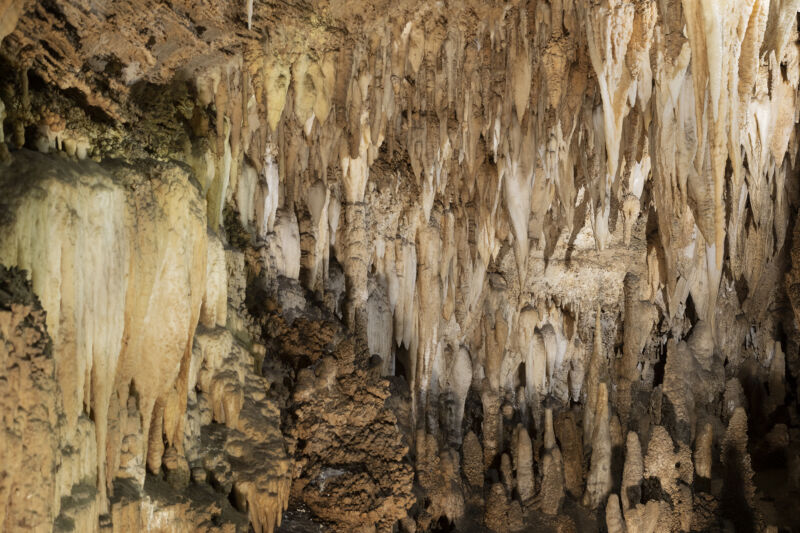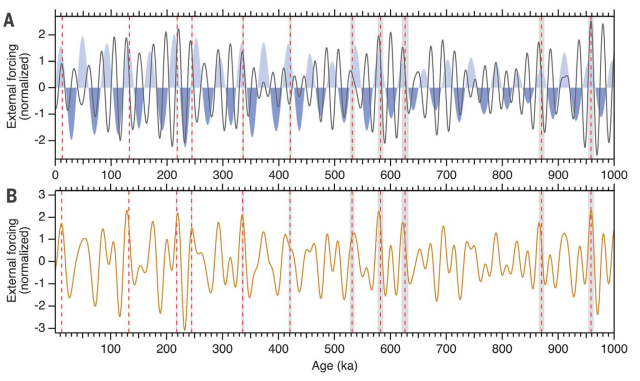
The general outlines of the ice ages of the last several million years are pretty well understood. The timing of the glacial cycles has been controlled by cycles in Earth’s orbit, with the temperature swings amplified by feedbacks in the Earth system via raised and lowered greenhouse gas concentrations. But having a general outline doesn’t mean there aren’t interesting questions within that big picture.
Some of those questions relate to a remarkable change in the ice age rhythm that occurred around a million years ago. Prior to this transition, the glacial cycles came and went on a roughly 41,000-year beat. This matches a cyclical pattern that changes the tilt of Earth’s rotational axis, strengthening and weakening the contrast between summer and winter. But after the transition, glacial cycles stretched out to about 100,000 years. That’s roughly the same length as a cycle that alters the shape of Earth’s orbit around the Sun.
The latter cycle is known to be too weak to really run the show. But there's a third influence: a roughly 23,000-year “precession” cycle that changes which section of Earth’s orbit each season occurs in. So what combination of these cycles explains the 100,000 year-heartbeat? And how could something suddenly take over tilt’s dominant role in the previous 41,000-year heartbeat?
Climate from caves
A new study led by Petra Bajo and Russel Drysdale of the University of Melbourne takes on these questions with the help of stalagmites from a cave in Italy. The drip-drip deposition of carbonate that slowly builds into stalagmites can create identifiable annual records of the chemistry of the rainwater seeping into the cave. Combined with radiometric dating of uranium that also gets trapped in the carbonate, researchers can get high-resolution climate records from these cave features.
The longest available ice core climate records don’t quite get back a million years, so anything past that is generally relying on seafloor sediment cores. The timeline on these sediment cores is not as precise as things like cave records or ice cores, which leads to a little quandary. Because we know the climate wiggles in the sediment records basically line up with orbital cycles, the orbital cycles are used to help set the timeline. That means these timelines aren’t necessarily much help in testing detailed hypotheses about the orbital cycles.
Enter the new Italian cave record. It covers a time period from 970,000 years ago to 810,000 years ago, with the age of each datapoint known to within 7,000 years. The cave record was also used to set the timeline for a recent seafloor sediment record. With both records in hand, the team compared glacial changes against the timing of the orbital cycles.
New timelines
A much-used seafloor core compilation put the length of the ice age in this time period at 92,000 years, but this new record shortens that to about 85,000 years. That shortened timing makes the end of both glacial periods (that is, the start of warming) line up with a peak in the tilt cycle, but only one of them lines up with a peak in the 23,000 year-long precession cycle. So this indicates that the tilt cycle was still the dominant factor, as it had been in the shorter ice ages previous.
Other cave records have filled in the last 640,000 years, so the researchers expanded their analysis over that time period, too. They found that the time between warming events was consistently a multiple of the 41,000-year tilt and 23,000 precession cycles. As others had already worked out, it’s sort of a coincidence that the average length comes out at about 100,000 years to match the third orbital cycle.
In looking at all the warming events together, the researchers argue that it’s not the case that precession took over control, writing that tilt “has clearly played an equal, if not greater, role.” While some events started with precession in a low phase, all started with tilt at a peak or on the way up.
But rather than look at two overlapping piles of spaghetti, they mixed the effects of tilt and precession into a single curve, laying that up against the full climate record. The result shows pretty obvious peaks that correspond to major warming events quite nicely. And that fits the varying length of recent glacial cycles, which were each between 85,000 and 120,000 years.

This all helps confirm that the transition to longer ice ages was driven by something inside the Earth’s climate system, rather than a change to the orbital pacemaker. It seems the world’s glacial configuration—with huge areas covered by ice sheets—crossed a sort of critical threshold that made it resilient enough to persist through some weaker orbital nudges. If you’ve ever run short of sleep long enough that you successfully slept through an alarm undisturbed, perhaps you can relate.
Science, 2020. DOI: 10.1126/science.aaw1114 (About DOIs).
"cycle" - Google News
March 14, 2020 at 02:26AM
https://ift.tt/2TLLC1r
Italian cave makes sense of the change in Earth’s ice age rhythm - Ars Technica
"cycle" - Google News
https://ift.tt/32MWqxP
Shoes Man Tutorial
Pos News Update
Meme Update
Korean Entertainment News
Japan News Update
Bagikan Berita Ini














0 Response to "Italian cave makes sense of the change in Earth’s ice age rhythm - Ars Technica"
Post a Comment